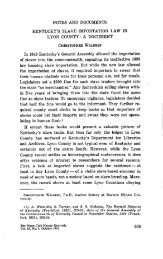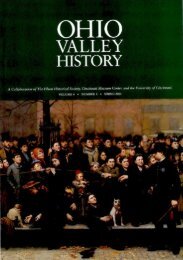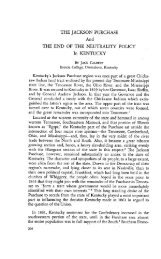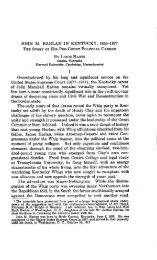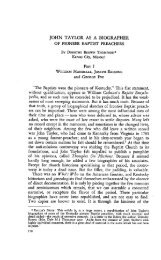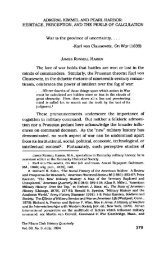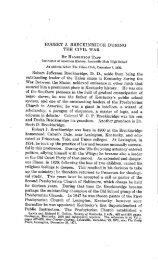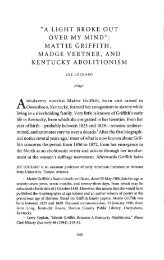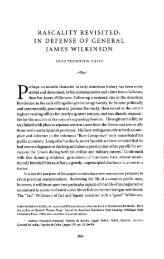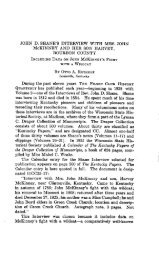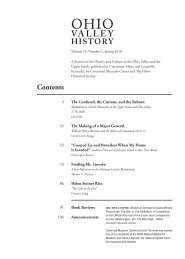FREDERICK LAW OLMSTED AND THE LOUISVILLE PARK ...
FREDERICK LAW OLMSTED AND THE LOUISVILLE PARK ...
FREDERICK LAW OLMSTED AND THE LOUISVILLE PARK ...
Create successful ePaper yourself
Turn your PDF publications into a flip-book with our unique Google optimized e-Paper software.
<strong>FREDERICK</strong> <strong>LAW</strong> <strong>OLMSTED</strong><strong>AND</strong> <strong>THE</strong> <strong>LOUISVILLE</strong> <strong>PARK</strong> SYSTEMBY VIRGINIA L. FITZPATRICK*It was not the best of days to be tramping through the underbrushalong Beargrass Creek, but Frederick Law Olmsted,America's first landscape architect, thought that he had neverseen a piece of property "more entirely endowed by nature withthe advantages for a beautiful park." The Louisville Post of May21, 1891, informed the public:In spite of the rain, Messrs. Olmsted and Henry Codman visitedthe new park purchase on Beargrass and other parks now in thehands of the [Park] Commissioners. The high praise which Mr. Olmstedbestowed upon the new purchase should be very satisfactory tothe people of Louisville.Andrew Cowan, one of Louisville's leading businessmen, had invitedOlmsted to speak at a dinner meeting the evening beforeon the subject of parks in general and the proposed park plansinvolving the Iroquois, Shawnee, and Cherokee areas in particular.This meeting was an attempt to persuade some of thecommunity leaders that the expense of a park system was worththeir support and that Olmsted was the proper man for planningthe system.Many attempts to have parks in Louisville were made between1779 and 1880, including proposals for parks in the areas aroundthe House of Refuge and Beargrass Point, on Corn Island, nearWestern cemetery, and on the banks of the Ohio River nearFourth Street. 1 The first city-owned and maintained public parkwas created in 1880 by moving a cemetery. After exhuming bones*VIRGINIA FITZPATRICK is a doctoral student at Indiafia University. Theinitial research for this paper was done under the guidance of Dr. WilliamMorgan at the University of Louisville. A presentation of this materialwas given at the June 1982 Frederick Law Olmsted Annual Conference inChicago.1 Andrew Cowan, "The Public Parks and Parkways," in J. StoddardJohnston, ed., The Memorial History of Louisville (Chicago: AmericanBiographical Publishing Company, 1896), II, 339.54
1985] Olmsted and Louisville's Parks 55Memorial History of LouisvilleAndrew Cowan
l • l i I i• r
56 The Filson Club History Quarterly [Vol. 59of pioneers who hadlain there for a hundred years, the oldgraveyard at Jefferson, between Eleventh and Twelfth streets,became Baxter Square Park. Cave Hill Cemetery was designedin 1847 as both a burial ground and as a recreational area withwinding roads, flowering trees, and quiet areas for contemplationin the undulating acres. Other attempts to create publicrecreational parks for Louisville, however, met with failure foreither monetary or political reasons.In 1851 Thomas Brown, a Louisville banker, sold eighty-twoand one-half acres of land to the city for the purpose of creatinga park. The park was not developed and in 1860 the city gavethe land to the House of Refuge with the reservation that fortyacres were to be used for a public park. According to AndrewCowan, writing in 1896, "Neither the whole eighty-two and onehalfacres nor the forty acres have ever been converted into apark.''2 The increasing pace of life, the cramped housing, poorsanitation, and pollution in much of central Louisville slowlyworked on the consciences of many civic-minded citizens. Thesecond half of the 19th century was a time of reflection on thewonders of nature and an appreciation of the benefits of thecountry atmosphere on the crowded tenement dwellers. ManyAmericans had been inspired by the centennial celebration tomake America more beautiful. City beautification was discussedin many of the periodicals and books present in Louisville homes.Louisville had a population of over 160,000 in 1887 and wasthe eighteenth largest city in the United States. It was still reapingthe benefits of increased financial investments as a resultof post-Civil War recovery and the successful Southern Expositionwhich had opened in 1883 and continued for several yearson land which later became Central Park. It was the righttime for another attempt to plan a park system. This time theappeal came from the highly respected Louisville lawyer, JohnMason Brown. Speaking before the Commercial Club, Brownsaid that he thought it "highly important" that a park system2 Ibld.
1985] Olmsted and Louisville's Parks 57be created. Louisville "must have parks and be a city or go onwithout parks and be avillage." His statement was "receivedwith applause....-3Thomas Speed, a member of the Salmagundi Club, raised thesubject of public parks at one of the fortnightly meetings.During the discussion, Andrew Cowan stated that he had beenstudying the methods by which other cities laid out their parksand that he hadalready explored several areas in Louisville.He presented his opinions and observations in a paper readbefore the Club and later before the Commercial Club. Thisspeech was published in its entirety by the Courier-Journal asa "matter of common interest.''4 Temple Bodley, a historianand park commissioner of the early 1900s, later described thespeech of Cowan :"He presented a strong argument for a threepart park system.., in its general lines like the one that wehave now. It was the real birth of the movement which ultimatelysecured our present parks.''sAndrew Cowan's great interest in aLouisville park systemwas based on his previous research which had made him a greatadmirer of Frederick Law Olmsted (1822-1903) who was regardedin 1880 as "the nation's principal environmental planner.''6Cowan wrote to 01msted at the firm's Brookline, Massachusettsaddress on January 8, 1891, asking about his system ofland selection and park design. Cowan told Olmsted that:As one of the Board of Park Commissioners, I am anxious that thework ... be started right... I insist that the first step to be taken isthe selection of a thoroughly competent landscape architect. If youare of that opinion, I shall be glad to have you emphasize it in yourletter... 7Cowan later stated that his "most valuable service as Park Commissioner,aside from the location of Cherokee Park, was through3 "The Commercial Club," Louisville Courler-Journal, July 8, 1887.4"Public Parks," Courier-Journal, June 5, 1887, p. 12.5 Temple Bodley, "The Park System of Louisville," p. 48. Bodley Collection,Manuscript Department, The Filson Club.6 Albert Fein, Frederick Law Olmsted and the American EnvironmentalTradition (New York: George Braziller, 1972), p. 27.7 Cowan to Olmsted, January 8, 1891, Frederick Law Olmstod Papers,Manuscript Division, Library of Congress.
58 The Filson Club History Quarterly [Vol. 59Frederick Law OlmstedNational Park Service, Frederick Law Olmsted National Historic Sitethe employment of Mr. Frederick Law Olmsted, the great landscapearchitect, as the builder of the Park." "I was," he wrote,"the only member of the Board who knew about the great reputationof Frederick Law Olmsted... I invited him to come toLouisville as my guest, to be present at a dinner in his honor
i, ¸ .........• ,l:• ¸, , : ,, )' , , •l'/,. ,,,", i ¸ •1 !'ll ', i IJ:J•;• I ',llhi i•,! •!i , !1 : : I•-L
1985] Olmsted and Louisville's Parks 59to which I would invite some twenty of our leading men.''sOlmsted's reputation was at its height in 1890 in other partsof the country. He was already internationally respected for thesuccess in 1857 of his (and Calvert Vaux's)New York CityCentral Park design which had helped start the great park buildingmovement in the United States. Over aforty year period,Olmsted worked on thirty-seven parks, sixteen community designs,and fourteen college campuses. During 1886 he and hisfirm had completed plans for Franklin Park in Boston and RiversidePark in New York City. In early 1890 Olmsted's firm wasinvolved in landscaping for Stanford College in Palo Alto, California,and the U.S. Military Academy at West Point. DuringAugust of that year Olmsted also agreed to landscape the groundsfor the Columbian Exposition in Chicago.9With all of this business onewonders why Olmsted wouldextend himself further by planning parks for Louisville. Perhapsthe results of a special park finance vote indicated to himthe strength of public support. Financing for the land purchaseand initial improvements was made possible by city bonds approvedby nearly 7,000 voters of Louisville on August 4, 1890.10A total of $600,000 was allocated with $200,000 set aside formaintenance.The overwhelming success of the Park bill vote was a vindicationof all those who hadbeen saying that the parks weredesired by all concerned citizens. The Louisville Post had stated,"It certainly seems.., that almost the entire population of Louisvillewas in favor of the Park bill. ''11 Many political problems regardinghis previous work on other parks had culminated inOlmsted's writing a bitter article in 1882 entitled "The Spoils ofthe Parks.''•2It is possible that he thought that Louisville offeredhim a more pleasurable working experience.8"Material Relating to Andrew Cowan," p. 16. Temple Bodley Collection,Manuscript Department, The Filson Club.9 Elizabeth Stevenson, Park Maker: A Life of Frederick Law Olmsted(New York: Macmillan Company, 1977), p. 392.10"The Old Story," Louisville Commercial, August 5, 1890.11 "Mr. Wallace and the Park Bi|l," Louisville Post, April 19, 1890.12 Elizabeth Stevenson, Park Maker, p. 359.
60 The Filson Club Histo•g Quarterly [Vol. 59The design of the Louisville park system came near the endof Olmsted's professional life; however, he had been in Louisvilleand its vicinity before. As a reporter for the New YorkTimes, he had traveled down the east coast and west to the borderof Texas in 1852. The following year he left New York andreturned to Texas traveling down the Ohio River and throughNashville, Tennessee; he returned through Georgia, North Carolina,and Virginia. 13 These were walking, horseback, and boattrips, so slow paced that he became acquainted with the people(urban and rural) and the flora of the South. 14 Olmsted visitedLouisville in 1858 as a newspaper reporter. He met with GeorgePrentice, editor of the Louisville Daily Journal to discuss businessrelating to the newspaper, and he also called on CharlesW. Short, a medical school professor and botanist.•During the Civil War, Olmsted had served as Secretary Generalof the Sanitary Commission. His inspection trips took himas far west as Cincinnati and St. Louis on the Ohio and Mississippirivers, and he may have checked the supply depot in Louisvilleduring these trips. 16 After the Civil War, Olmsted believedthat landscape architecture provided him a way to "render asocial service to solve the problems of a changing nation.''17 Healso believed that landscape architecture had a "promising futurein the South.''18 As one of his earliest landscape commissions,Olmsted designed the interior park area at the JeffersonviUe,Indiana, Quartermaster Army Depot in 1873.19In response to Cowan's January 1891 letter, company partner13 Ibld., p. 97.14 Ibid., p. 88.15 Charles Beveridge, ed., The Papers of Frederick Law Olmsted--Slav-•y and the South, 185•-57 (2 vols.; Baltimore: The Johns Hopkins UniversityPress, 1981) II, 232, 472. \16 Elizabeth Stevenson, Park Maker, p. 234.17Julius Gy. Fabos, Gordon Milde, and V. Michael Weinmayr, FrederickLaw Olms•ed, St., Founder o] Landscape Architecture in America (Amherst:The University of Massachusetts Press, 1968), p. 13.18Laura Wood Roper, FLO: A Biography of Frederick Law Olms•ed(Baltimore: The Johns Hopkins University Press, 1973), p. 452.19 Letters from James Gall, Jr., and the Quartermaster General in Washington,D.C., October 16, 1873 and February 16, 1874 to Frederick LawOlmsted, Jeffersonville, Indiana file, Olmstod Papers, Library of Congress.
1985] Olmsted and Louisville's Parks 61Henry Codman made apreliminary visit in mid-February. Aweek later the Olmsted firm offered to design the three parksystem envisioned by Cowan for the initial sum of $250.00 plustraveling expenses with an additional charge for preparing thegeneral plans and "incidental services" while they were beingcarried out at a rate of $12.50 an acre.20 During the next twomonths the city attempted to lower the acreage rate. At the sametime a dissident group was advocating the services of ClarenceParsons who worked in the City Engineering Department andwho claimed aknowledge of park architecture. In an effort topersuade the citizens, Cowan finally decided to have a dinner onMay 20 at the Pendennis Club to which he invited twenty ofLouisville's leading businessmen. According to Cowan, Olmsted'stalk "captured" the group and created such an interest in hismethods that the idea of employing Parsons was dropped,mThe Cou•er-Journal published a letter to the editor on May24, 1891, which stated that:To use effectively and economically our natural advantages and limitedfinancial resources the Park Commissioners determined to callMr. Olmsted into consultation and he has been in the city during thepast week. Mr. Olmsted speaks enthusiastically of the advantagesthe city has already secured and believes that with judicious expenditure,Louisville may, in a little time, have a system of parks that willcompare favorably with the parks of other cities. There is a unityabout his work as there is about a picture. The purpose is to furnishto the thousands of citizens, weary of brick and mortar and granitestreets, relief, rest and recreation. The park must rest the eye, thebrain, the heart, the soul of man. 22Louisville newspapers urged acceptance of Olmsted's services.The Louisville Times asserted that "it was of vital importancethat the very beginnings of the park system should be formulatedandprojected upon correct principles. ''zs The Louisville Commercialadded that "the expense of a few hundred dollars in theemployment of Mr. Olmsted is wise and judicious. The city can20 F. L. Olmsted and Company to Thomas Shirley, February 26, 1891,Olmsted Papers, Job File 1260, Library of Congress.21 "Material Relating to Andrew Cowan," p. 16.22"Building Parks," Courier-Journal, May 24, 1891.23 Louisville Times, May 23, 1891, p. 4.
62 The Filson Club History Quarterly •[Vol. 59not afford to make mistakes in matters of such importance. Asingle blunder might be more expensive than all that is paid tothus secure the best skill. ''24In a short time most of the influential people in Louisvillewere convinced that Olmsted was the right choice. The LouisvillePost, in anticipation of the signed contract, stated that "the ParkCommissioners are to be congratulated on securing the servicesof Frederick Law Olmsted and Company to develop the landscapebeauties of the park system. They are the most famouslandscape engineers in the country and have a reputation extendingto Europe. ''s5During the week after the Pendennis dinner, OlmstedandCodman walked through the proposed park sites, and the May22 issue of the Courier-Journal stated:Messrs. Codman and Olmsted are busily engaged, surveying theproperty, in order to estimate the cost of the improvements needed...the landscape architects spend a part of each day at Eastern Parkprosecuting their labors and drawing designs such as the topographysuggests.26On June 17 a contract from the Park Board was made with F. L.Olmsted and Company "to furnish working plans for the improvementof all the parks under the control of [the] Board. ''2•On June 29 Cowan wrote to Olmsted asking his advice aboutpurchasing more land for roadways and parks. This correspondencewith Olmsted continued for three more years with Olmstedhimself occasionally making direct suggestions.A report from the F. L. Olmsted and Company was formallymade to the Park Commission on September 20, with definitesuggestions for the character of each park. Iroquois Park wasto be of "a sequestered character -- a treasure of sylvan scenery•.. [with] the grandeur of the forest depths in the dim seclusionof which [one] may wander musingly for hours.., and from its24 "Well Done," Louisville Commercial, May 24, 1891.25 "The Public Parks," Louisville Post, May 23, 1891.26"A Western Park," Courier-Journal, May 22, 1891.27First Annual Report of the Board of Park Commissioners of the C•tyof Louisville (Louisville: Courler•Journal Job Printing Company, 1891),p. 20.
1985] Olmsted and Louisville's Parks 632"c•
64 The Filson Club History Quarterly [Vol. 59upper parts, fine, broad, distant prospects are to be had." ShawneePark was to possess "broad and tranquil meadowy spaces... offering areas of turf to be inexpensively kept in a suitablecondition for lawn games." The report continued with a descriptionof Cherokee.Park as a place of "refreshment that is to behadin the contemplation of snpe:b umbrageous trees.., distributednaturally upon a gracefully undulating green sward.To procure such scenery in higher perfection than.., it is yetto be found in any public park in America, all that is needed isthe removal of fences and a little judicious use of the ax." Olmsted'sidea was to adopt a design suited to local conditions avoidingornamentation, roads, buildings, and monuments that werenot necessary to "quickly giving people a chance to cheaply, convenientlyand pleasantly escape at times from the town and comeunder the influence of one or another form of agreeable scenery.''s8The Louisville Commercial headlined the report "As toParks--The Policy That Will Make Them Perfect in EveryDetail."29Work continued on the three parks, according to the correspondencebetween the Park Board and F. L. Olmsted and Company,for the next twenty-four years. A letter from Olmsted toAndrew Cowan dated May 26, 1891, recommended the hiring ofEmil Mahlo as landscape engineer since he was one who "hadan unusual aptitude for the business.''3s Olmsted continued tocheck on the work for three years through infrequent visits andthe observations of his partners. One of his last letters fromLodisville mentions a meeting of the Park Board on March 14,1894, at which he "reported at length and with satisfactory results.''alThe following year Olmsted's. declining health forcedhis retirement, and his work in Louisville was continued by hissons, John and Frederick, Jr., and other partners.28 Ibid., pp. 55-56.29 "As To Parks," Louisville Commercial, September 20, 1891.30 F. L. Olmsted to Andrew Cowan, May 26, 1891, Letterbook, Vol. 14,pp. 869-70, Olmsted Papers, Library of Congress.31"Louisville IV" file, March 15, 1894, Olmsted Papers, Library of Congress.
1985] Olmsted and Louisville's Parks 65Ninety years after Olmsted said that the "prime object of thepark.., is to provide.., a retreat.., with soothing and reposefulinfluences," the beauty of his Louisville parks continue toappeal to its citizens. Attempts to introduce recreational activitiesinconsistent with Olmsted's principles have been foughtthrough the years. Despite the losses due to organized sports,the invasion of Interstate 64, the devastating tornado in 1974,the noise of model airplanes, automobiles, and motorbikes, theparks, designed as an escape from urban conditions, continue tosurvive. The picturesque vistas in Frederick Law Olmsted's Louisvilleparks may now be interrupted by archery targets, trafficsigns, trash cans, golf courses, and tennis courts, but a turn ofthe head frequently brings a glimpse of nature as Olmsted intended-"a retreat as completely rural in character as the circumstanceswould admit.''•232 Frederick Law Olmsted, Jr., Forty Years of Landscape Architeetuve-Frederick Law Olmsted, St. (Cambridge: Massachusetts Institute of TechnologyPress, 1928), p. 278.



